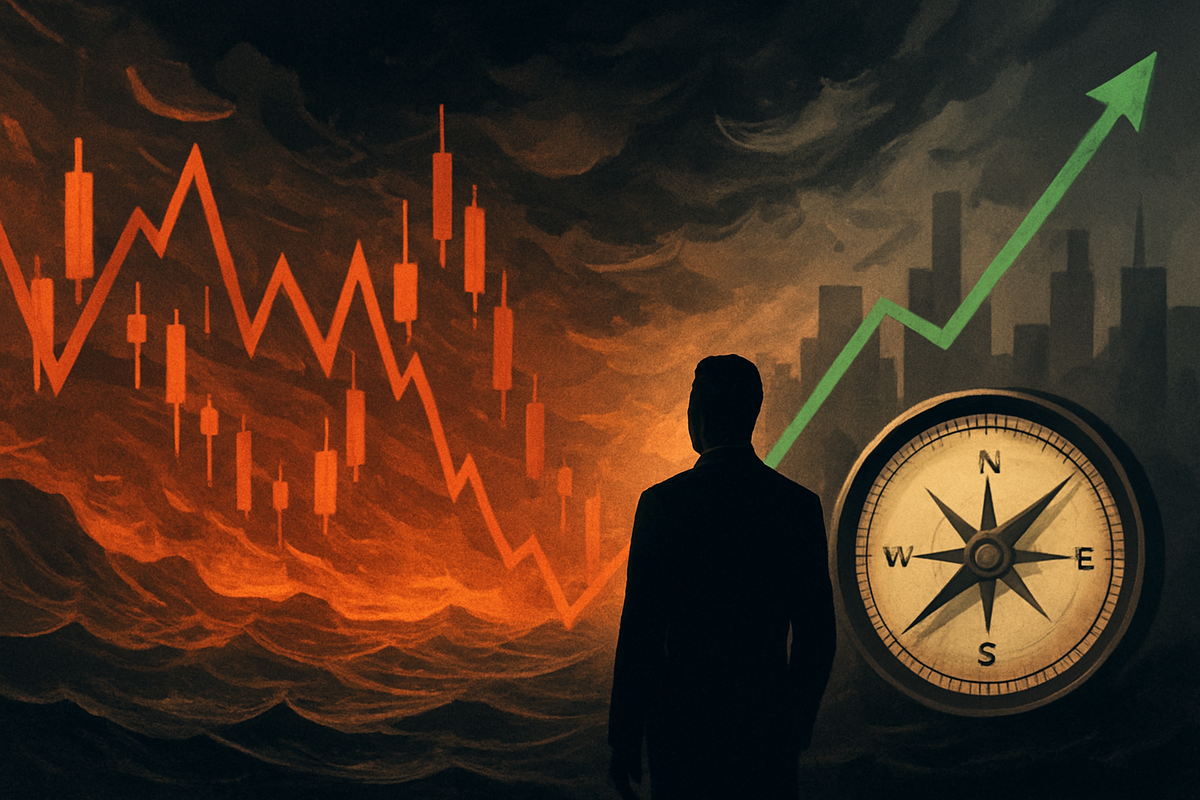
The global stock market is currently in the throes of significant volatility, a condition marked by sharp, unpredictable price swings and a palpable sense of investor unease. As of November 7, 2025, Wall Street's "fear gauge," the CBOE Volatility Index (VIX), remains elevated, signaling a period of heightened risk and caution across major indexes, including the Dow Jones Industrial Average (DJIA), S&P 500 (SPX), and Nasdaq Composite (IXIC). This turbulence is not merely a fleeting moment but rather a complex confluence of economic and geopolitical forces that have been building over the past few years, demanding a strategic re-evaluation from investors worldwide.
This environment necessitates a proactive approach to risk management and a keen eye for opportunities that may emerge from the dislocation. Investors are grappling with inflated valuations in key sectors, particularly AI and technology, alongside persistent geopolitical tensions and evolving interest rate expectations. The immediate implications include increased investor caution, a rapid reassessment of corporate valuations, and the urgent need for adaptability. While the short-term outlook suggests continued turbulence, resilient companies and strategic asset allocation could pave the way for long-term gains, challenging investors to distinguish between transient noise and fundamental shifts.
The Unfolding Market Tremors: A Deep Dive into Current Volatility
The current market tremors, particularly evident in the downturn of major U.S. and European indices, are a culmination of several interconnected factors. A primary driver of this unease is the widespread concern over "sky-high valuations" within the technology sector, especially those linked to Artificial Intelligence. Despite some robust earnings reports, many tech stocks have faced sell-offs as investors question the sustainability of their growth and the long-term monetization strategies within the AI industry, leading to growing whispers of a potential "AI bubble." This tech-led sell-off has notably impacted the Nasdaq Composite (IXIC), positioning it for its worst weekly performance since March.
The timeline leading up to this moment traces back to a multi-year trend of economic and geopolitical shifts originating in 2023. Ongoing geopolitical conflicts, including the Russia-Ukraine war, the Israeli-Palestinian conflict, and Houthi attacks in the Red Sea, coupled with unpredictable trade policies and the looming "Trump effect" on tariffs, have injected a persistent layer of uncertainty. Central banks, notably the U.S. Federal Reserve, also played a crucial role, with an aggressive rate-cutting cycle in late 2024 following earlier efforts to combat inflation, continuously influencing market sentiment. Adding to the jitters are concerns over the U.S. economy, with recent data showing a jump in job layoffs in October and a retreat in consumer sentiment, alongside a U.S. government shutdown that has limited official economic data, forcing reliance on private indicators.
Key players and stakeholders involved in this scenario include central banks, major institutional investors, and individual retail investors, all reacting to and influencing market movements. Prominent bank CEOs have issued warnings about a potential equity drawdown, highlighting the narrow market breadth where a few mega-cap tech stocks have outperformed the broader market, raising questions about sustainability. Initial market reactions have been characterized by rapid reassessments of corporate valuations, particularly for high-growth technology companies, leading to sharp sell-offs and billions wiped off market capitalization. This environment has also triggered mechanical deleveraging, where institutional portfolios are forced to reduce exposure across the board when volatility surges, amplifying downturns even for fundamentally strong positions.
Companies in the Crosshairs: Winners and Losers in a Volatile Market
In a period of heightened stock market volatility, certain companies are inherently better positioned to weather the storm, while others face significant headwinds. The current environment, characterized by concerns over inflated tech valuations and economic uncertainty, creates a distinct set of potential winners and losers.
Companies with strong balance sheets, diversified revenue streams, and essential product or service offerings are likely to emerge as relative winners. These often include established players in defensive sectors such as utilities, consumer staples, and healthcare. For instance, companies like Johnson & Johnson (NYSE: JNJ) or Procter & Gamble (NYSE: PG), with their stable demand and consistent cash flows, tend to be more resilient during downturns. Furthermore, businesses that can demonstrate consistent profitability and have less reliance on speculative growth narratives will be favored. Value stocks, which have often been overlooked during periods of tech-driven exuberance, might also see renewed interest as investors seek more stable and tangible assets. Companies with robust free cash flow generation and the ability to return capital to shareholders through dividends or buybacks may also attract capital as investors seek tangible returns in uncertain times.
Conversely, companies heavily reliant on high-growth narratives, particularly those with speculative valuations in the technology and AI sectors, are most vulnerable. Many of the "mega-cap" tech companies that have driven market gains in recent years, such as Nvidia (NASDAQ: NVDA) or even some less established AI startups, could face continued pressure as investors scrutinize their long-term monetization strategies and question the sustainability of their rapid growth. Companies with high debt loads, those sensitive to interest rate fluctuations, or those operating in discretionary consumer sectors could also struggle as economic uncertainty curbs consumer spending and tightens credit conditions. Furthermore, businesses with less adaptable supply chains or significant exposure to geopolitical hotspots could experience disruptions and increased operational costs, impacting their profitability and investor confidence. The "narrow market breadth" observed, where a few mega-cap tech stocks have disproportionately influenced market performance, suggests that a broader correction could disproportionately affect these highly concentrated segments.
Broader Significance: Unpacking the Wider Implications of Market Volatility
The current wave of stock market volatility transcends immediate price fluctuations, signaling deeper shifts within the global financial landscape. This event fits squarely into broader industry trends marked by an increasing intertwining of technological innovation, geopolitical instability, and evolving monetary policies. The intense focus on AI valuations, for instance, highlights a recurring pattern of market exuberance followed by skepticism in nascent, high-growth sectors. It underscores the challenge for investors to differentiate between genuine transformative potential and speculative bubbles, a trend that has historically played out across various technological revolutions.
The ripple effects of this volatility are extensive, impacting competitors, partners, and the broader economic ecosystem. Companies that are heavily integrated into the supply chains of vulnerable tech giants or those reliant on discretionary consumer spending could face significant headwinds. Conversely, competitors with more conservative valuations or diversified product portfolios might find opportunities to gain market share or attract capital. Regulatory bodies are also closely monitoring the situation. Concerns over market concentration and potential "AI bubbles" could prompt increased scrutiny from financial regulators, potentially leading to new policies aimed at safeguarding market stability or curbing speculative excesses. The ongoing U.S. government shutdown, limiting the availability of official economic data, further complicates regulatory responses and investor decision-making.
Historically, periods of heightened market volatility have often preceded significant economic shifts or policy changes. Comparisons can be drawn to the dot-com bubble burst of the early 2000s, where inflated tech valuations eventually corrected sharply, or to the financial crisis of 2008, which exposed systemic risks and led to extensive regulatory overhauls. While the specific catalysts differ, the underlying themes of speculative excess, geopolitical uncertainty, and monetary policy adjustments echo these historical precedents. This current environment serves as a potent reminder that market cycles are inevitable and that understanding historical patterns can offer valuable insights into potential future trajectories, even as unique contemporary factors shape the present.
What Comes Next: Navigating the Future of Market Volatility
The path forward for the stock market in the wake of current volatility is likely to be characterized by continued uncertainty, yet it also presents distinct opportunities for discerning investors. In the short term (next 6-12 months), market turbulence is expected to persist, driven by ongoing geopolitical risks, unpredictable trade policies, and persistent inflation. Investors should anticipate further price swings and be prepared for potential drawdowns, particularly in sectors with elevated valuations. The "mechanical deleveraging" phenomenon, where institutional portfolios are forced to reduce exposure, could amplify these short-term movements, making agility and robust risk management paramount.
Long-term possibilities, however, suggest a potential rebalancing of the market. If a deep recession is avoided, the market could demonstrate underlying resilience. This period of revaluation might lead to a healthier, more fundamentally driven market, as speculative excesses are flushed out. Companies demonstrating strong financial health, diversified operations, and adaptable supply chains are better positioned for sustained growth. Potential strategic pivots for businesses include prioritizing cash flow generation over aggressive growth, strengthening balance sheets, and diversifying geographical exposure to mitigate geopolitical risks. Investors, similarly, may need to adapt by focusing on quality assets, embracing diversification beyond traditional growth stocks, and potentially exploring alternative investments that are less correlated with equity market movements.
Emerging market opportunities may arise in undervalued sectors or companies that have been unfairly penalized during broad sell-offs but possess strong fundamentals. Sectors like essential infrastructure, certain segments of healthcare, and companies with proven dividend yields could become more attractive. Challenges will include navigating continued interest rate uncertainty and the potential for further economic slowdowns. Scenarios range from a gradual market stabilization and a return to more sustainable growth, albeit at a slower pace, to a more pronounced correction if economic data deteriorates further or geopolitical tensions escalate significantly. Investors should closely monitor central bank communications, inflation data, and key geopolitical developments for signals regarding these potential outcomes.
Comprehensive Wrap-up: Charting a Course Through Turbulent Waters
The current stock market volatility, driven by a complex interplay of inflated tech valuations, persistent geopolitical tensions, evolving monetary policies, and economic uncertainties, represents a critical juncture for investors. Key takeaways from this period include the urgent need for a reassessment of risk, the importance of fundamental analysis over speculative growth narratives, and the inevitable nature of market cycles. The "fear gauge" (VIX) remains elevated, underscoring that this is not a transient blip but a sustained period of turbulence demanding strategic adaptation.
Moving forward, the market is likely to remain challenging in the short term, with continued price swings and the potential for further corrections, particularly in overvalued segments. However, beneath the surface, opportunities will emerge for resilient companies and discerning investors. The market's resilience will ultimately hinge on the ability of economies to navigate ongoing headwinds without falling into a deep recession and the capacity of companies to adapt to changing consumer behaviors and global supply chain dynamics.
The lasting impact of this period could be a shift towards a more value-oriented investment landscape, where robust balance sheets, consistent profitability, and tangible assets are prioritized. Investors should watch for several key indicators in the coming months: the trajectory of inflation and subsequent central bank interest rate decisions, geopolitical developments (especially those impacting energy and trade), and corporate earnings reports, which will provide crucial insights into company-specific resilience. A close eye on consumer sentiment and employment data will also be vital in gauging the overall health of the economy. Prudence, diversification, and a long-term perspective will be the cornerstones of successful investing in this evolving market environment.
This content is intended for informational purposes only and is not financial advice





